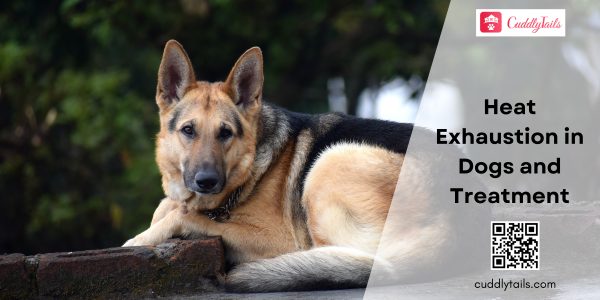Heat Exhaustion in Dogs and Treatment
One critical aspect of their health that often gets overlooked is the risk of heat exhaustion, especially during the warmer months. Unlike humans, dogs don’t sweat the same way we do, making them more susceptible to heat-related illnesses. Understanding and preventing heat exhaustion is crucial to keeping our pets safe and healthy.
Understanding Heat Exhaustion in Dogs
What is Heat Exhaustion?
Heat exhaustion in dogs occurs when their body temperature rises to dangerous levels, typically above 103°F. This condition can lead to complications and even be life-threatening if not treated promptly.
Causes of Heat Exhaustion in Dogs
Heat exhaustion in dogs can be caused by various factors such as excessive heat and humidity, inadequate ventilation, and strenuous activity in hot weather. Certain breeds, like brachycephalic dogs, are more susceptible to heat exhaustion due to their anatomy.
Signs and Symptoms of Heat Exhaustion
Physical Signs to Watch For
Watch out for symptoms like excessive panting, drooling, red gums, vomiting, and rapid heart rate. Your dog may also show signs of weakness, staggering, or collapsing, indicating a severe case of heat exhaustion.
Behavioral Changes in Dogs with Heat Exhaustion
Dogs experiencing heat exhaustion may display anxiety, restlessness, confusion, or even aggression. They may seek cool surfaces or shade, and in severe cases, they might become unresponsive or disoriented.
Prevention of Heat Exhaustion in Dogs
Strategies for Keeping Dogs Cool in Hot Weather
Provide access to shade, and fresh water, and avoid exercising during peak temperatures. Use cooling mats, vests, or bandanas, and never leave your dog in a hot car. Adjust exercise routines to the cooler parts of the day.
Recognizing High-Risk Situations
Avoid leaving your dog in enclosed spaces without adequate ventilation, such as cars or poorly ventilated rooms. Be cautious during heatwaves or high humidity days, and consider your dog’s individual tolerance to heat based on breed and health status.
Immediate First Aid for Heat Exhaustion
Steps to Take When Suspecting Heat Exhaustion
Move your dog to a shaded or air-conditioned area and offer small amounts of water. Contact your veterinarian immediately for guidance and monitor your dog’s condition closely.
Cooling Techniques for Dogs in Distress
Use cool, not cold, water to wet your dog’s body, focusing on the neck, armpits, and groin area. Place wet towels on their body, use fans, or ice packs wrapped in a cloth to help lower their body temperature gradually.Veterinary Treatment for Heat Exhaustion
When your furry friend is feeling the heat, it’s important to seek veterinary treatment promptly. To diagnose heat exhaustion in dogs, veterinarians may conduct diagnostic procedures such as physical examinations, blood tests, and monitoring vital signs.
Medical Care For Heat Exhausted Dogs
Diagnostic Procedures
In the world of doggy diagnostics, vets will typically examine your canine companion thoroughly to assess their condition. This may involve checking their temperature, heart rate, and hydration levels. Blood tests can also help determine any internal imbalances caused by heat exhaustion.
Medical Interventions and Therapies
Once the diagnosis is in, veterinarians may recommend medical interventions and therapies to help your pup cool down and recover. This could include intravenous fluids to rehydrate, medications to reduce inflammation, and supportive care to stabilize their condition.
Recovery and Follow-Up Care
After the heat wave has passed, it’s essential to focus on your dog’s recovery and provide proper follow-up care. Monitoring their progress closely and adhering to dietary and activity recommendations are crucial steps in ensuring a smooth recuperation.
Monitoring Dog’s Progress After Heat Exhaustion
Keep a close eye on your four-legged friend as they bounce back from heat exhaustion. Watch for any signs of relapse or complications, and seek veterinary assistance if you notice any concerning symptoms. Regular check-ups can help track their recovery journey.
Dietary and Activity Recommendations for Recovery
During the recovery phase, your dog may benefit from a balanced diet and controlled activity levels. Your vet might suggest specific dietary changes and restrictions on strenuous exercise to aid in their healing. Remember, patience and pampering go a long way in helping your pup feel like themselves again.
Importance of Monitoring Dogs in Hot Weather
As the temperature rises, so does the importance of keeping a watchful eye on your furry companions. Dogs can easily overheat in hot weather, leading to potentially dangerous conditions like heat exhaustion. Be proactive in preventing heat-related illnesses by providing shade, water, and never leaving your pooch in a parked car on a scorching day. Your vigilant care can make all the difference in keeping your dog cool as a cucumber when the heat is on.
Conclusion
Heat exhaustion in dogs is a serious condition that requires immediate attention. By understanding the signs, taking preventive measures, and knowing how to respond if your dog shows symptoms, you can protect your furry friend from this dangerous situation. Remember, a little preparation goes a long way in keeping your dog safe and happy during the warmer months.
Frequently Asked Questions (FAQs)
What are the first signs of heat exhaustion in dogs?
The first signs often include excessive panting, drooling, and lethargy. Your dog may also appear unsteady or confused.
Can all dogs get heat exhaustion, or are some more at risk?
While all dogs can suffer from heat exhaustion, brachycephalic breeds, older dogs, puppies, and those with health issues are at higher risk.
What should I do if my dog shows symptoms of heat exhaustion?
Move your dog to a cool area, offer water, and use cool (not cold) water to dampen their fur. Seek veterinary help if symptoms are severe.
How can I keep my dog cool during a heatwave?
Provide plenty of water, ensure access to shade, use cooling products, and avoid exercising during peak heat times.
Is it safe to take my dog for a walk in the summer?
Yes, but it’s best to walk them early in the morning or late in the evening when temperatures are cooler. Avoid hot surfaces and always carry water.

